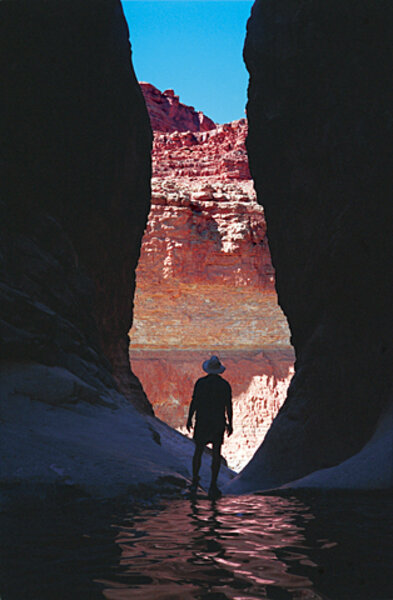A hiking trail down time's spiral
Loading...
My husband has some friends who live in Arizona, about two hours from the Grand Canyon. One year a friend of theirs, a geologist named Dave, came to visit, and they proudly drove him to see the national park. Many people feel overwhelmed the first time they glimpse the Grand Canyon, but for geologists, visiting it is like finally beholding the Holy Grail. Earth hides most of her history, burying it underneath mountains or sinking it below oceans. The Grand Canyon is one of the few spots where the planet's past is laid bare for anyone to see.
Dave needed to leave in an hour, so he couldn't hike the eight-mile trail that winds down to the canyon floor – but he wanted to walk the first quarter mile, just to get a taste. His friends sat down on a park bench, and Dave trotted off in his sneakers, carrying a small water bottle. An hour later, they were worried. Two hours later, they started down after him. It was 95 degrees F. that day, and a hiker needs a gallon of water just to make it to the bottom – a 17-mile journey that drops nearly a full vertical mile from the rim to the Colorado River. It's the sort of jaunt the Park Services strongly advise against.
It was after dark when they finally spotted Dave, heading back up to the canyon rim, walking by moonlight under a starry sky. They were furious to see him smiling. When they asked what had happened, he shrugged. "You know, I kept meaning to turn around. Then I would see something ahead I wanted to look at, something I'd never seen before, and I'd say to myself, OK, I'll turn around in five minutes. I kept doing that, and before I realized it, I was at the bottom." Other hikers had taken pity on Dave all day long, doling out sips from their water bottles to the jubilant, dusty man who had never seen the Grand Canyon before.
In a way, it's not surprising that the Grand Canyon can make you forget time, because time is what the canyon is all about. Not seconds and minutes and hours, the stuff that human time is made of. To the canyon, a human being is pretty much the same thing as a mayfly, an insect that can hatch, reproduce, and die, all between one sunrise and the next.
Time isn't some abstract concept in the canyon, but a story that you walk through. You take your first steps over the Kaibab formation, a creamy stone speckled with fossil worms and fish teeth. These are the youngest rocks in the canyon, but they predate dinosaurs by 25 million years. Go another mile, and you're walking on rust-colored Hermit shale, imprinted with fossils from the planet's first ferns.
Down you go, descending into a well of time. Each formation striping the canyon walls is a different color. Every time you walk into a new shade of tan or ocher or burnt sienna, you've moved deeper into the past. The names of the rocks sound like a mantra that takes you back to the beginnings of the planet: Toroweap, Coconino, Supai, Vishnu.
I hiked to the bottom of the canyon once myself. When my boyfriend proposed we fly Phoenix, drive to the canyon, hike to the bottom, and camp out there, it held the allure and bravado of a jailbreak. We arrived at the park just as the sun was setting, and Patrick made me close my eyes as he parked our car at the rim. He led me, blind, all the way to the overlook. He wanted my first sight of the Grand Canyon to be the whole thing. That night, we went to sleep with snowflakes pinging off our tent near the rim. The next day when we hiked down, the temperature at the bottom hit 85 degrees F.
It was mid-May, and the desert was blooming. I had expected the canyon to be magnificent, but desolate. Instead, its slopes were washed with magenta and orange flowers, humming with bees, hung with miniature waterfalls. We went to sleep under a moon that was bright enough to read by, the Colorado River chuckling softly as we slept.
Of all the places I've ever traveled, the Grand Canyon is somehow the hardest to pin down. Although it's pictured on millions of refrigerator magnets, postcards, and coffee mugs, the canyon is impossible to truly capture in snapshots. As a place, it's more like a movie than a photograph. Sunbeams break against the walls, clouds cast down shadows, and the colors ripple and shift like an ocean of light. The sheer vastness of the space never comes across in pictures. Once you've been there, looking at a photo is like looking at a disappointing picture of a friend, the kind where you shake your head and say, "No, this one doesn't really look like you at all."
Perhaps Einstein was right, and time spirals in on itself. That would explain why one summer in your childhood can last forever – and how a man can hike clear to the bottom of the Grand Canyon five minutes at a time.





